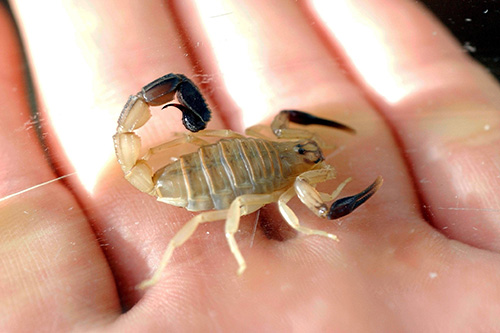Medical researchers at FAU identify scorpion venom as possible cancer treatment

Image: Colourbox.de
Researchers at Universitätsklinikum Erlangen at Friedrich-Alexander-Universität Erlangen-Nürnberg (FAU) have now examined a substance that is often used in traditional Chinese medicine – scorpion venom – and used it to treat particularly severe brain tumours, with surprising results.
In traditional Chinese medicine, extracts from the venom of the Chinese golden scorpion (Mesobuthus martensii) are considered particularly effective against neurological disorders such as chronic pain, paralysis, strokes and epilepsy.
In collaboration with Chinese microbiologists, medical researchers at FAU have identified two new active agents extracted from this venom that can stop so-called gliomas, brain tumours that are currently very difficult to treat.
The team led by neuroscientist PD Dr. Nicolai Savaskan were able to show that the two substances, known as CA4 and CTX-23, prevent the rapid division of tumour cells and stop the formation of tumour blood vessels.
'The two scorpion venom derivatives that we have found are a good example of how traditional Chinese medicine can enrich western medicine – and are promising treatments for our patients.'
The researchers have recently published their findings in the journal Scientific Reports.
Further information for patients:
Phone: +49 9131 8549000
krebsinformation@uk-erlangen.de
Information for the press:
PD Dr. Nicolai Savaskan
Phone: +49 9131 8534626
nicolai.savaskan@uk-erlangen.de
Media Contact
More Information:
http://www.fau.de/All latest news from the category: Life Sciences and Chemistry
Articles and reports from the Life Sciences and chemistry area deal with applied and basic research into modern biology, chemistry and human medicine.
Valuable information can be found on a range of life sciences fields including bacteriology, biochemistry, bionics, bioinformatics, biophysics, biotechnology, genetics, geobotany, human biology, marine biology, microbiology, molecular biology, cellular biology, zoology, bioinorganic chemistry, microchemistry and environmental chemistry.
Newest articles

Innovative vortex beam technology
…unleashes ultra-secure, high-capacity data transmission. Scientists have developed a breakthrough optical technology that could dramatically enhance the capacity and security of data transmission (Fig. 1). By utilizing a new type…

Tiny dancers: Scientists synchronise bacterial motion
Researchers at TU Delft have discovered that E. coli bacteria can synchronise their movements, creating order in seemingly random biological systems. By trapping individual bacteria in micro-engineered circular cavities and…

Primary investigation on ram-rotor detonation engine
Detonation is a supersonic combustion wave, characterized by a shock wave driven by the energy release from closely coupled chemical reactions. It is a typical form of pressure gain combustion,…



